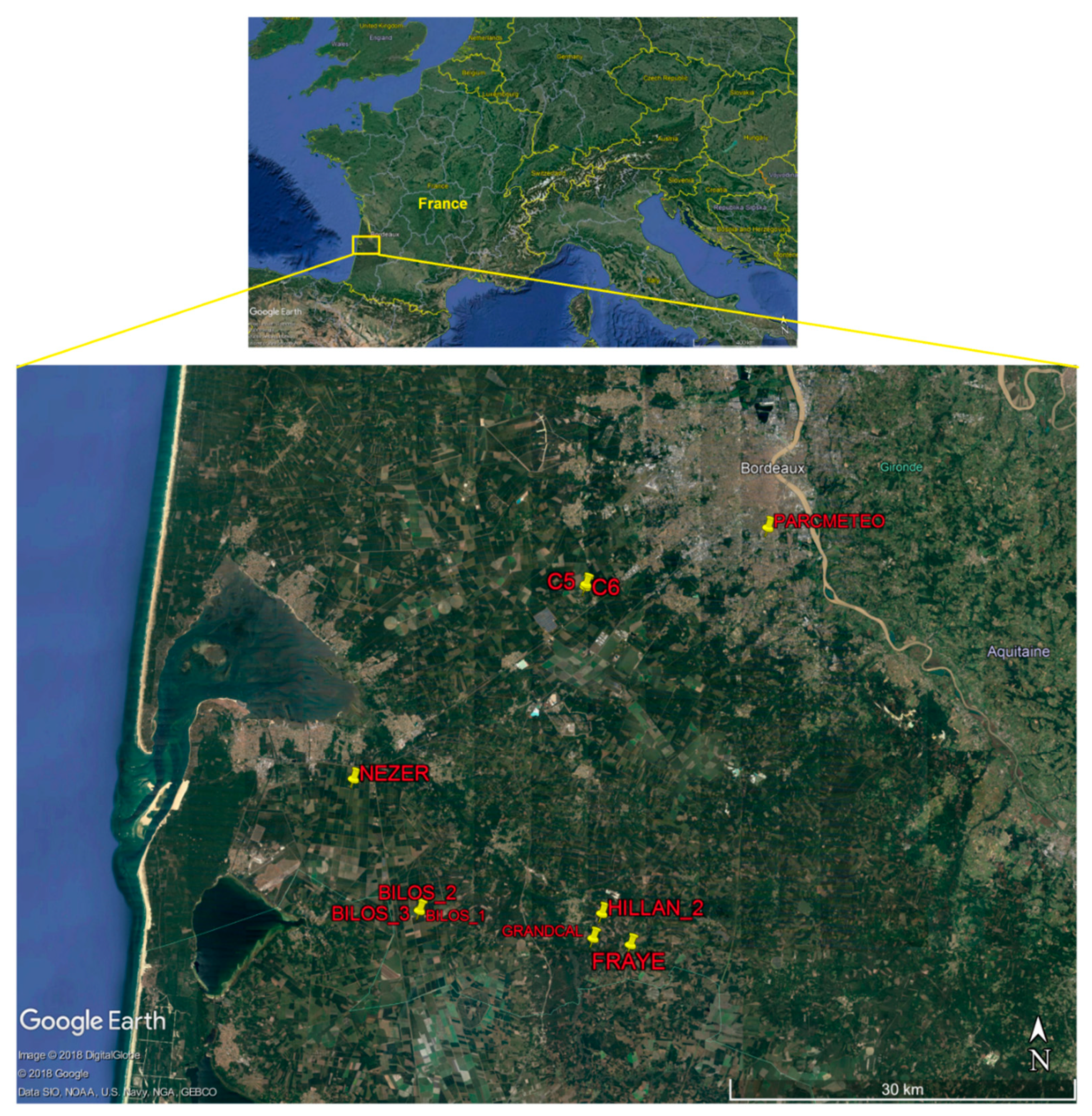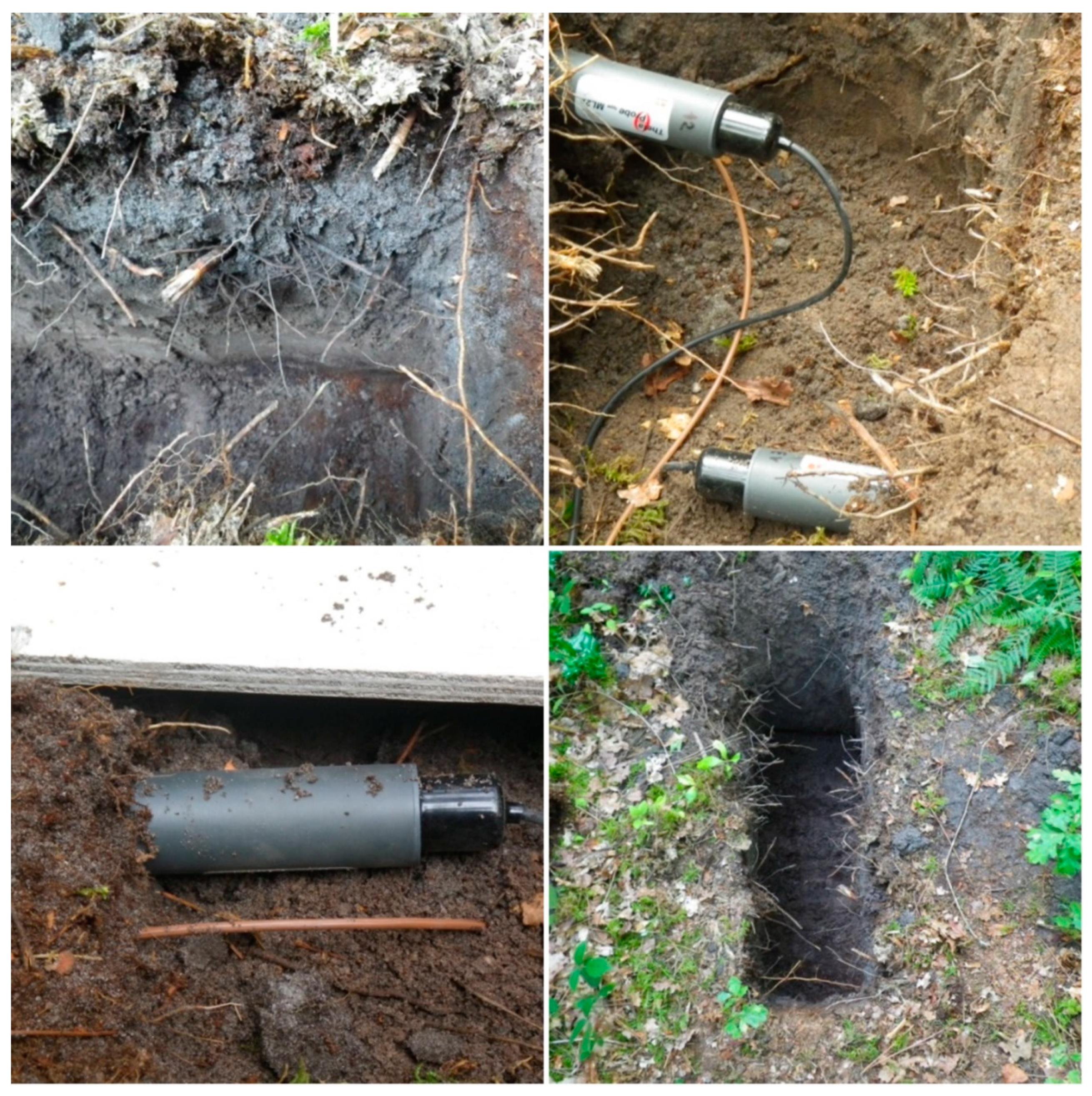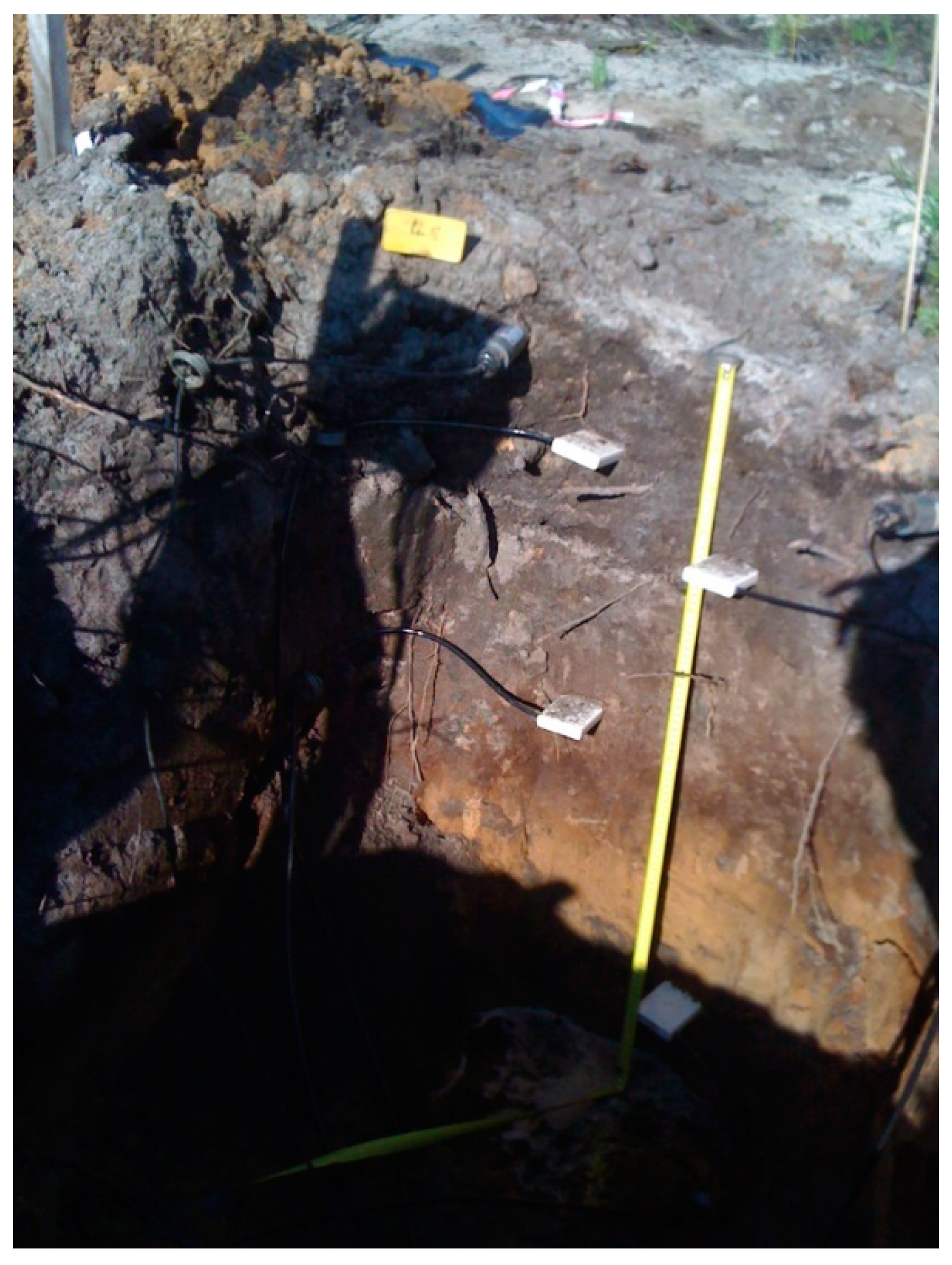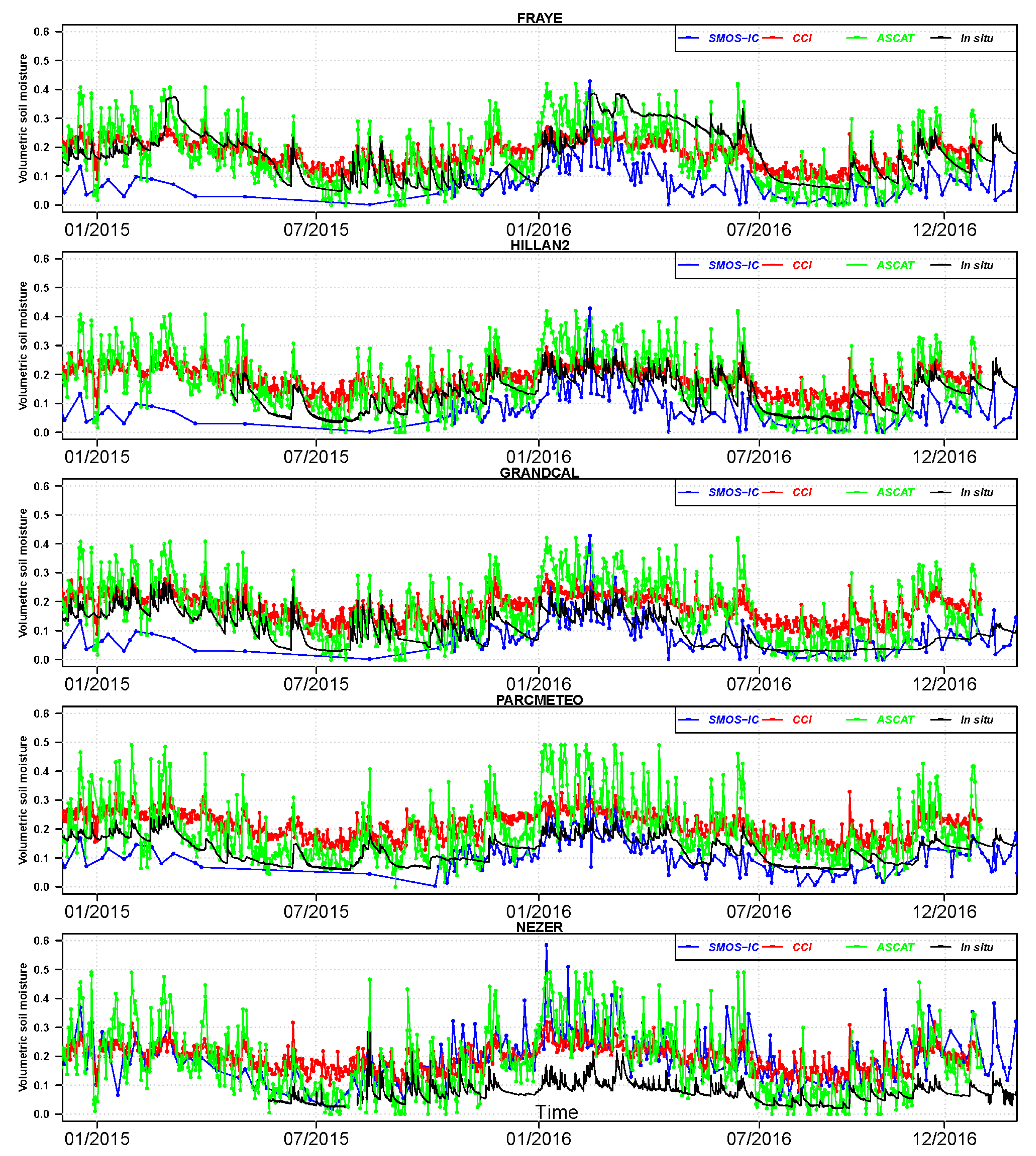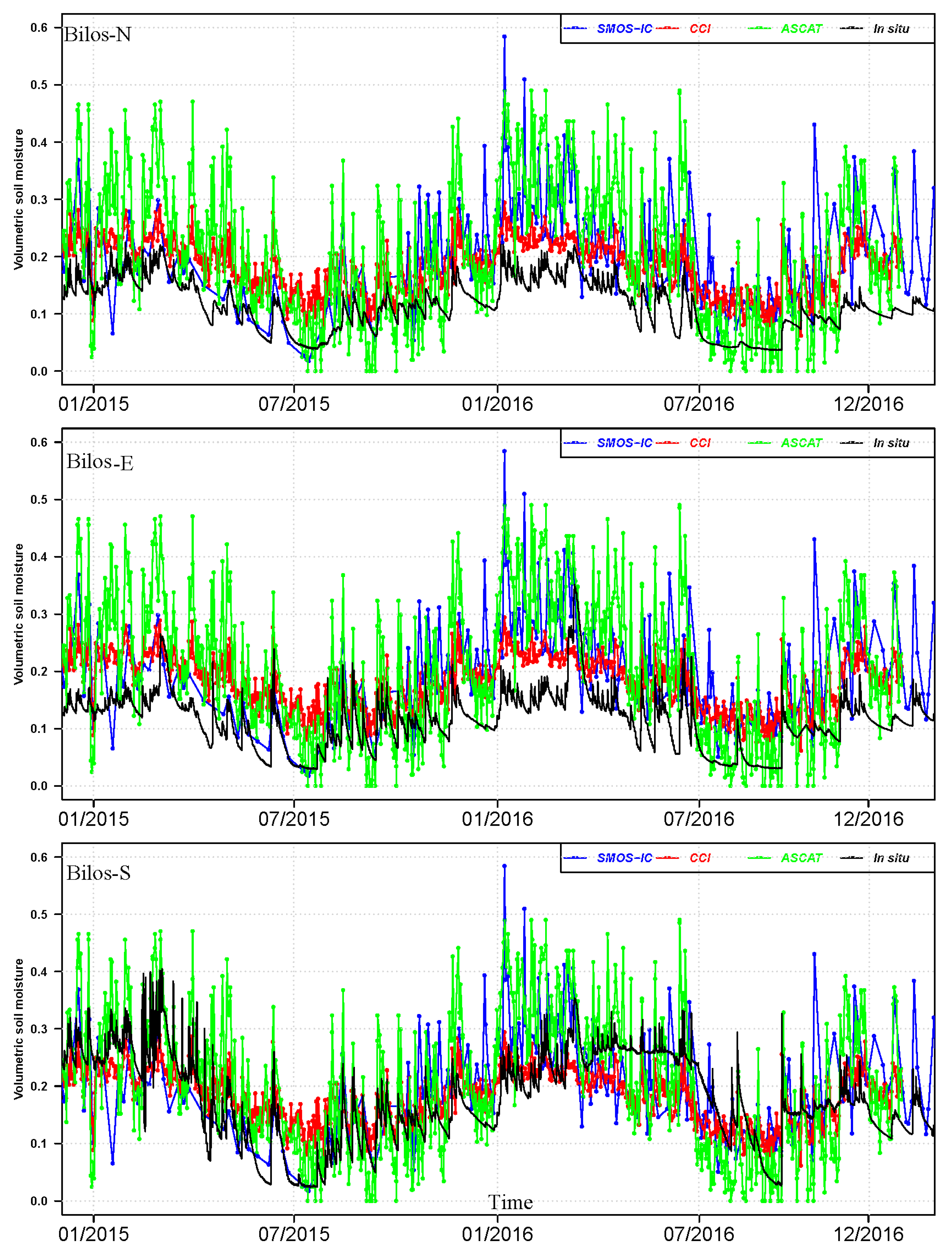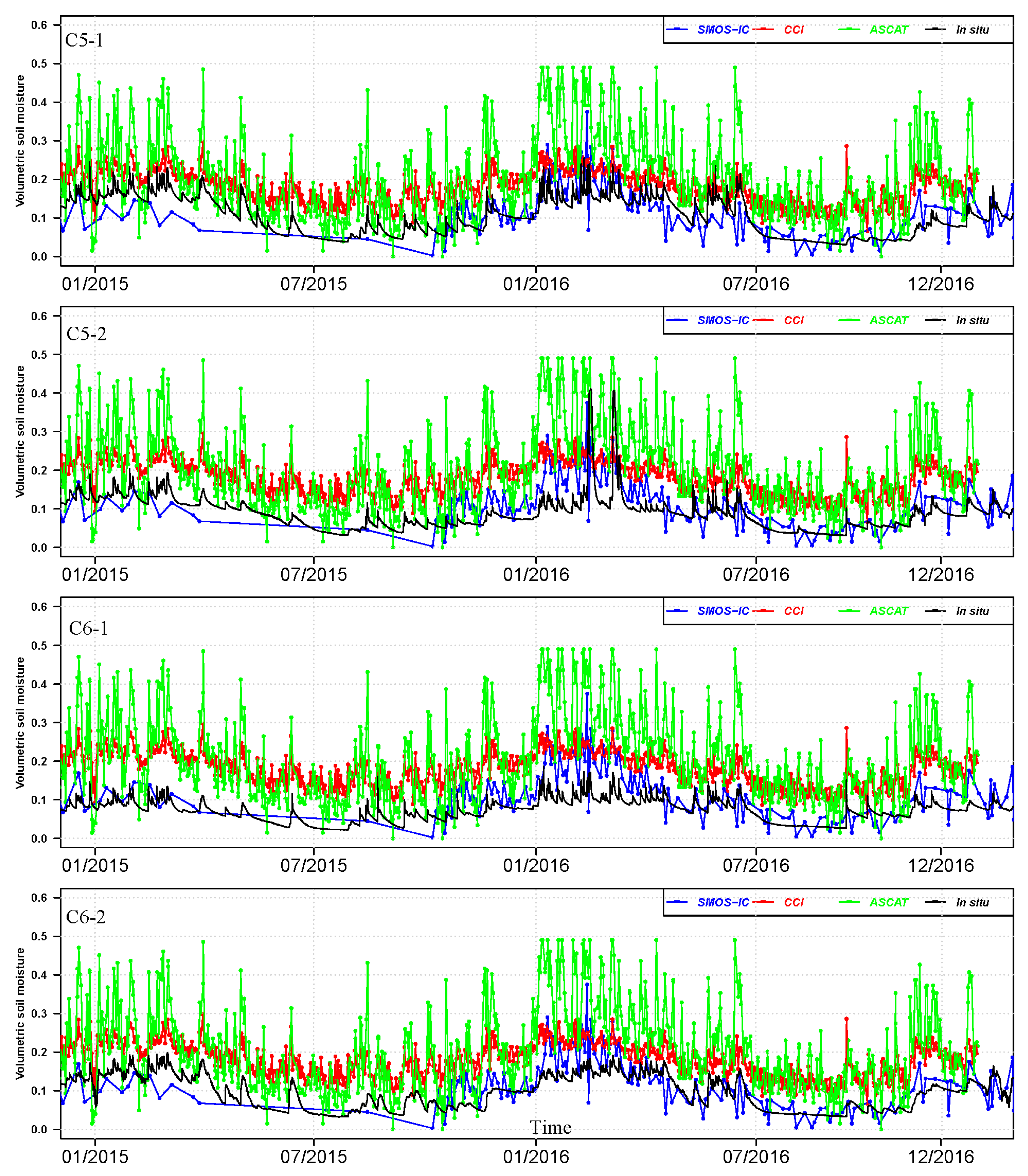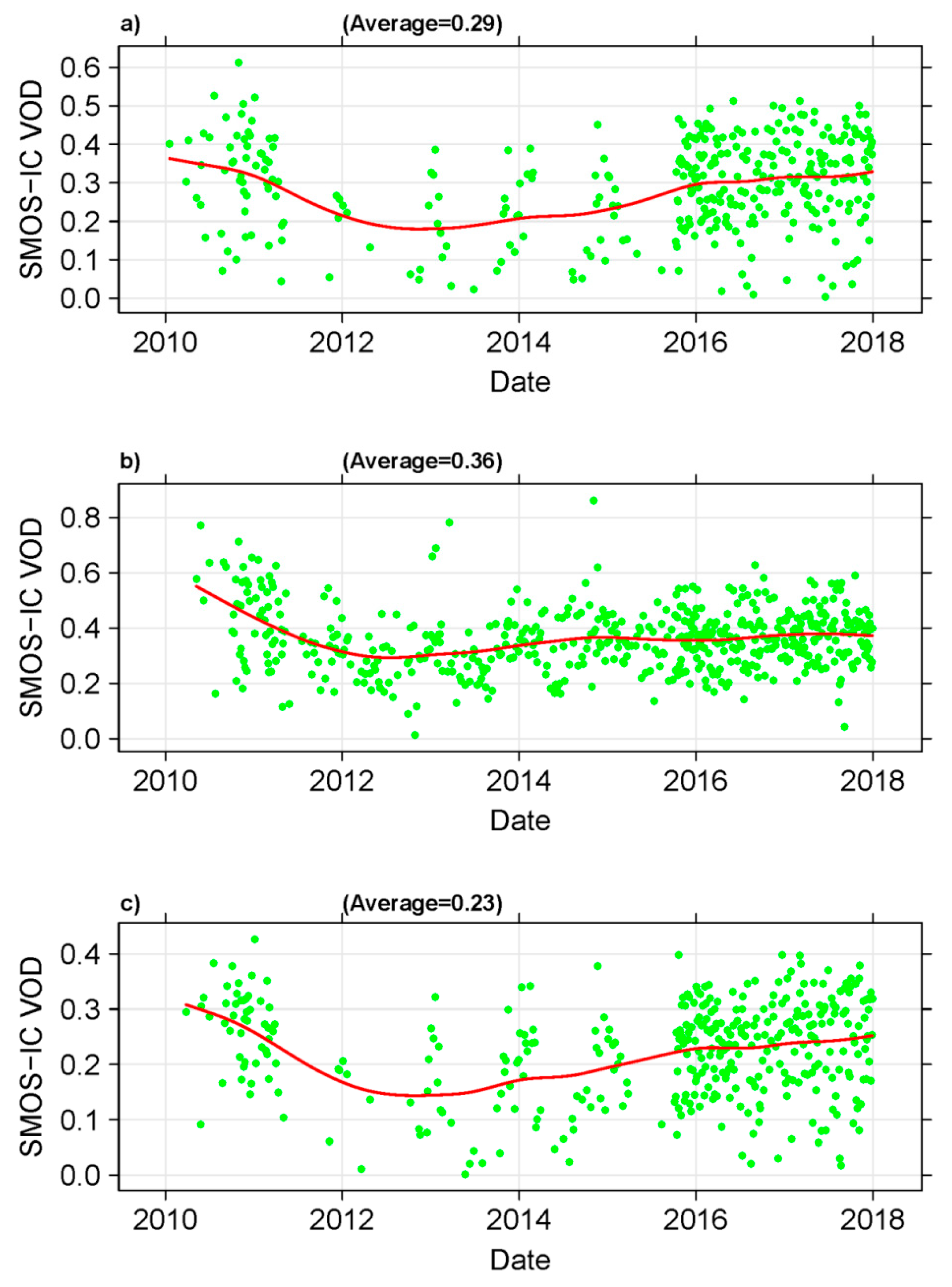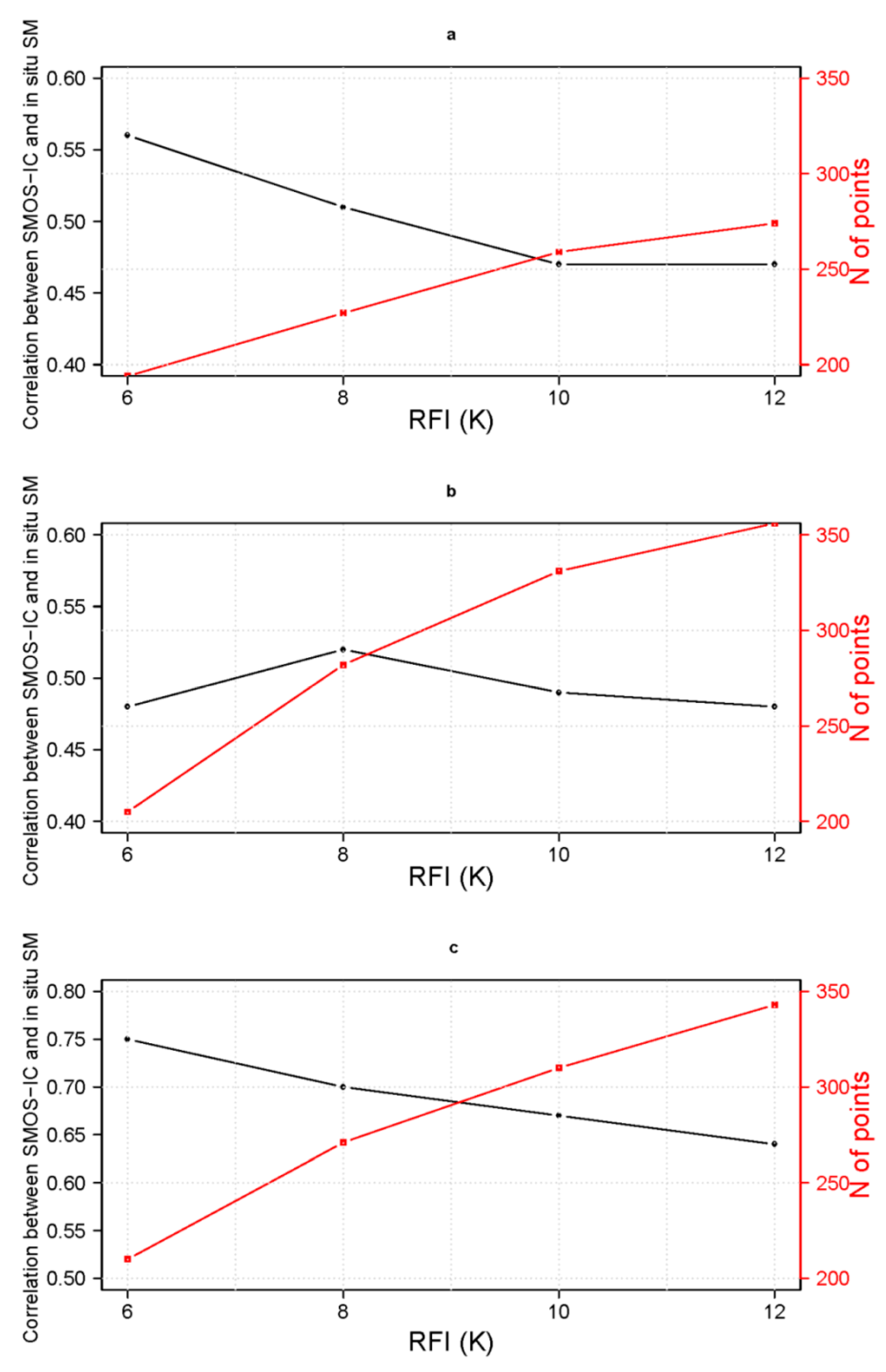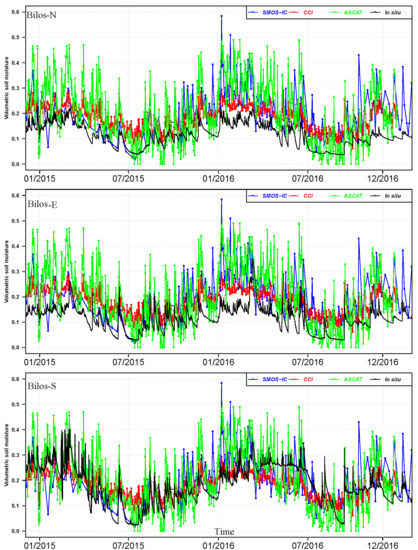1. Introduction
Surface Soil moisture (SM), which refers to the water content in the top soil layer, plays a key role in land surface and atmospheric processes, by influencing the exchange of energy, water and carbon dioxide fluxes between them [
1,
2]. Continuous measurements for monitoring SM deem necessary for various agriculture and hydrological applications (e.g., agricultural drought monitoring, flood forecast, yield forecasting, monitoring of greenhouse gase emissions and reservoir management) [
3,
4]. Soil moisture observations can be obtained either locally using ground-based measurements or globally using microwave remote sensing techniques [
5,
6].
More specifically, SM can be inferred from brightness temperatures (TB) and backscatter coefficients measured by passive and active microwave sensors [
5,
6,
7,
8], respectively. Recent passive remote sensing satellites include, but not limited to, the two dedicated SM missions: the National Aeronautics and Space Administration (NASA) SMAP (Soil Moisture Active Passive) satellite and the Soil Moisture and Ocean Salinity (SMOS) satellite. Active remote sensing sensors include, but not limited to, the ESA Advanced Scatterometer (ASCAT) sensor. Furthermore, based on these (and others) passive and active datasets, a long term (~35 years of data) SM product was developed by the European Space Agency (ESA); the so-called climate change initiative (CCI) SM product.
After the launch of several space-borne microwave satellites such as the SMOS satellite, calibration/validation studies using ground-based measurements are useful and important to assess the quality of the space-borne observations. This led to the development of integrative systems such as the so-called the ISMN (International Soil Moisture Network). ISMN collects ground-based SM measurements and hosts currently a large number of SM networks (~59), obtained from validation campaigns and operational networks, over various regions of the world [
9,
10]. The French AQUI network (Bordeaux–Aquitaine region), for instance, is one of the most recent networks that were included in the ISMN network. This network is a flat area of dense pine forests, making it interesting for calibration/validation (cal/val) studies, as few sites in ISMN have been set up for similar vegetation conditions [
11]. The site is therefore very useful for the evaluation of microwave products over forested areas.
The AQUI network which was set up by INRA (National Institute of Agricultural Research), consists of in situ stations equipped with sensors to measure SM and soil temperature at various depths. These stations were equipped during 2009–2013 in the framework of the ESA SMOS satellite and ICOS (Integrated Carbon Observation System) project. The AQUI network has not been yet exploited and used to validate microwave remote sensing SM retrievals.
In this context, the objective of this study is twofold: presenting the main characteristics of the French AQUI network and evaluating, for the first time, SMOS, ESA CCI, and ASCAT SM products over this network. This paper is organized as follows. The AQUI network and the remotely-sensed SM observations used in this study as well as the methodology are described in
Section 2. Then,
Section 3 presents the evaluation results. Discussion and conclusions are drawn in
Section 4.
4. Discussion and Conclusions
Based on the statistics and time series presented in the previous section, the three products were able to reproduce the annual cycle of all stations in the AQUI network. All the three SM products overestimated the AQUI network SM data (except a few stations for SMOS-IC). It was found that ASCAT and CCI had often equivalent performances in terms of correlations and better performances than SMOS-IC over the Bouron and Bilos stations. The similarity in the performance, only in terms of correlations, between CCI and ASCAT is not unexpected. This can be linked to the fact that ASCAT is one of the sensors used to produce the CCI SM product and as this region is highly impacted by RFI [
21], CCI was more influenced by active products than passive products. However comparable performances between the three products were found over the Hermitage stations. These results could be explained by the fact that the Bilos and Bouron stations are closer to water bodies (ocean, rivers, and lakes), which influences the inversion of SM from TB or backscatter observations, than the Hermitage stations. Moreover, SMOS had better results (and comparable to CCI and ASCAT) over the Hermitage stations than over the Bouron and Bilos stations. In terms of short term variations and day to day fluctuations, the correlations values decreased for all products but ASCAT had the best overall correlations over most of the sites considered in this study. The best capability of ASCAT to capture short terms variations over Europe is consistent with the findings of Al-Yaari et al. [
35,
36] and [
36].
Note that the SM retrievals are strongly impacted by the vegetation density. For instance,
Figure 7 shows time series of SMOS-IC VOD over the Bouron, Bilos, and Hermitage regions. The low number of SMOS retrievals before 2016 for the Bouron and Hermitage sites, in
Figure 7, is due to the filtering of SMOS data with RFI > 8 K. At the end of 2015/beginning of 2016, it seems the source of RFI was off as RFI values were significantly decreased and much more SMOS-IC retrievals were available. It seems that the Bilos site (
Figure 8b) was less impacted by RFI effects and much more retrievals were available before 2016 than for the other sites (the scatter in the VOD data is slightly lower too over Bilos).
The yearly average of VOD is good a proxy of biomass [
37] and we see from this figure that the Aquitaine region is moderately vegetated with average values of VOD of ~0.3, corresponding to an average biomass density of ~60 t/ha. It can be seen in
Figure 7a,b that VOD values can be as high as 0.6 (mainly in 2010), corresponding to an average biomass density of ~120 t/ha. Over the three sites, it is likely the decrease in VOD after 2010 is due to residual effects of the impact of the big Klaus storm beginning of 2009 and to forestry work following the storm. A detailed evaluation of the vegetation effects on the performance of the different SM products is outside the scope of the paper, but these effects will be investigated more in depth in future studies.
In addition, the whole region in Aquitaine is highly impacted by RFI in the protected L-band which has a strong impact on the performances of SMOS.
Figure 8 shows an example illustrating how the accuracy of the SMOS-IC SM retrievals is sensitive to RFI. In
Figure 8a,c the correlation values between the SMOS-IC SM retrievals and the Bouron (Fraye) and Hermitage (C6-1)
in situ SM measurements increased when RFI were more strongly filtered (RFI were filtered using the TB-RMSE index which is a good proxy of the RFI intensity). The counterpart of the higher filtering process of the RFI effects is a lower number of data. However, this is not always the case as illustrated in
Figure 8b for the Bilos site, where the correlation value had a low sensitivity to the RFI filtering threshold (best results obtained when the threshold was set equal to 8 K). This could be explained by the fact that, as noted before, the Bilos site was much less impacted by RFI effects before 2016 than the other sites. Therefore, filtering RFI is highly dependent on the study region. It should be noted that other studies evaluated SMOS and compared it to ASCAT, SMAP, and CCI SM products over other regions with low or no RFI and found it to be very skillful e.g., [
35,
38,
39,
40,
41].
Although the AQUI network is very close to the ocean, which affects the remote sensing SM retrievals, the findings of this study showed that all the three remotely-sensed SM products have reasonable performances in terms of both temporal dynamics and absolute values. The discrepancies especially the systematic errors between the remotely-sensed SM retrievals and the AQUI network can be generally explained by sampling depth mismatch between the satellite-based SM retrievals (~3 cm) [
42] and the
in situ measurements. In addition, one should not neglect inaccuracies in both the satellite-based SM algorithms or in the set-up of the AQUI
in situ observations. These factors may impact the statistics either separately or in combination depending on the site location.
In conclusion, this is the first study where the AQUI network in South-Western France was presented and used to evaluate the SMOS-IC, CCI, and ASCAT SM products. For the evaluation, the Pearson correlation coefficient (R), Bias, RMSE, and ubRMSE scores were computed. Except for one specific site (slightly lower performances were obtained over Bilos_S), the results for both ASCAT and CCI were found to be relatively homogeneous over the different sites, in terms of correlation, bias, RMSE and UbRMSE. This is a very positive result and no clear interpretation of the results relative to the soil properties (gravelly or sandy soils) or vegetation (more or less vegetated sites) conditions can be drawn. For instance, relatively similar performances were obtained over the Parcmeteo site (gravelly soil in the Bordeaux suburbs), forested sites of Nezer, Bilos, Hermitage and over the Bourron sites which include the densest forest cover (forest cover fraction ~90%). The results of SMOS-IC were found to be strongly dependent on the RFI conditions that depend on the site location and time (for instance, lower RFI effects were generally found after 2016).
Generally, the agreement between the AQUI SM data and the CCI SM product was the best (except for anomalies where ASCAT was the best). In this regard, one should keep in mind that CCI is combining the best retrievals of several sensors and thus high quality is expected. In addition, SMOS observations are strongly affected by RFI over the AQUI sites. The present study showed, that in spite of the high level of RFI effects, SMOS-IC could produce correct SM retrievals, if accurate filtering procedures are applied.
The statistics, temporal dynamics in particular, of the comparisons of SMOS-IC, CCI, and ASCAT along with AQUI network shown in the previous section are in range with other evaluation results over other networks. This demonstrates that the AQUI network is likely to be well-suited for satellite microwave remote sensing evaluation/validation. Further investigation is needed to address the discrepancies between the satellite-based SM retrievals and the AQUI network.
